Abstract
1. Binding of [3H]-leukotriene B4 ([3H]-LTB4) to murine spleen membranes (MSM) was determined. 2. Scatchard analyses of [3H]-LTB4 binding indicated the presence of high (KD1 = 1.7 nM) and low (KD2 = 7.5 nM) affinity receptors on MSM with Bmax values of 151 fmol mg-1 protein (Bmax1) and 354 fmol mg-1 protein (Bmax2), respectively. 3. CP-105,696, a potent LTB4 antagonist, inhibited [3H]-LTB4 (0.67 nM) binding to the high affinity receptor on MSM, IC50 = 30.2 nM, Ki = 17.7 nM with a Hill coefficient of 0.93. 4. Scatchard analyses of [3H]-LTB4 binding to MSM in the presence of CP-105,696 indicated that the high-affinity receptor was inhibited in a non-competitive manner and the low-affinity receptor in a competitive manner. 5. Isolated peripheral blood murine neutrophils (MN) responded chemotactically to LTB4, EC50 = 2.5 nM. CP-105,696 blocked this response, IC50 = 2.3 nM. When examined over a full concentration-response range of LTB4, CP-105,696 inhibited chemotaxis in a non-competitive manner. 6. Murine neutrophils in anticoagulated whole blood upregulated the integrin, complement receptor type 3 (CD11b/CD18, Mac-1) in response to LTB4, EC50 = 20 nM and this was inhibited by CP-105,696 in a competitive manner. 7. These results provide evidence that MSM have specific binding sites for LTB4, and as exemplified by CP-105,696, that these receptors may be useful for determining the potency and nature of antagonism of novel LTB4 receptor antagonists.
Full text
PDF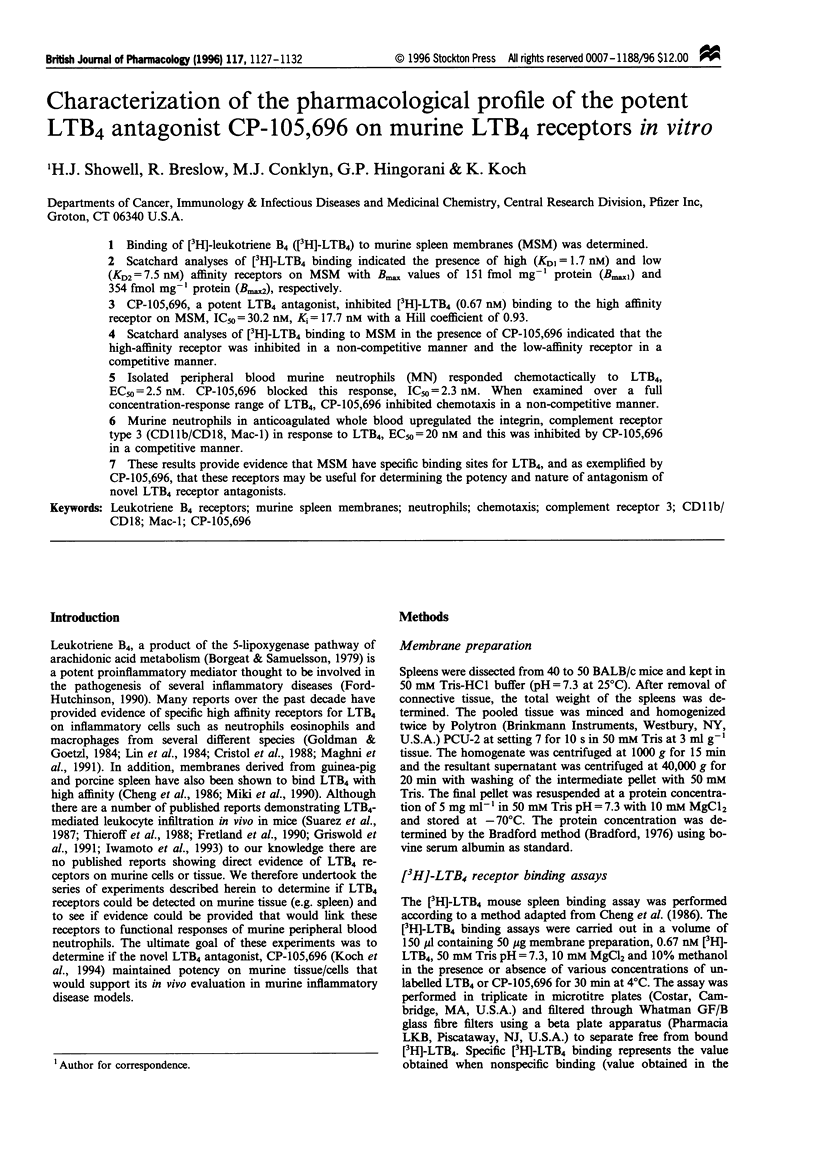

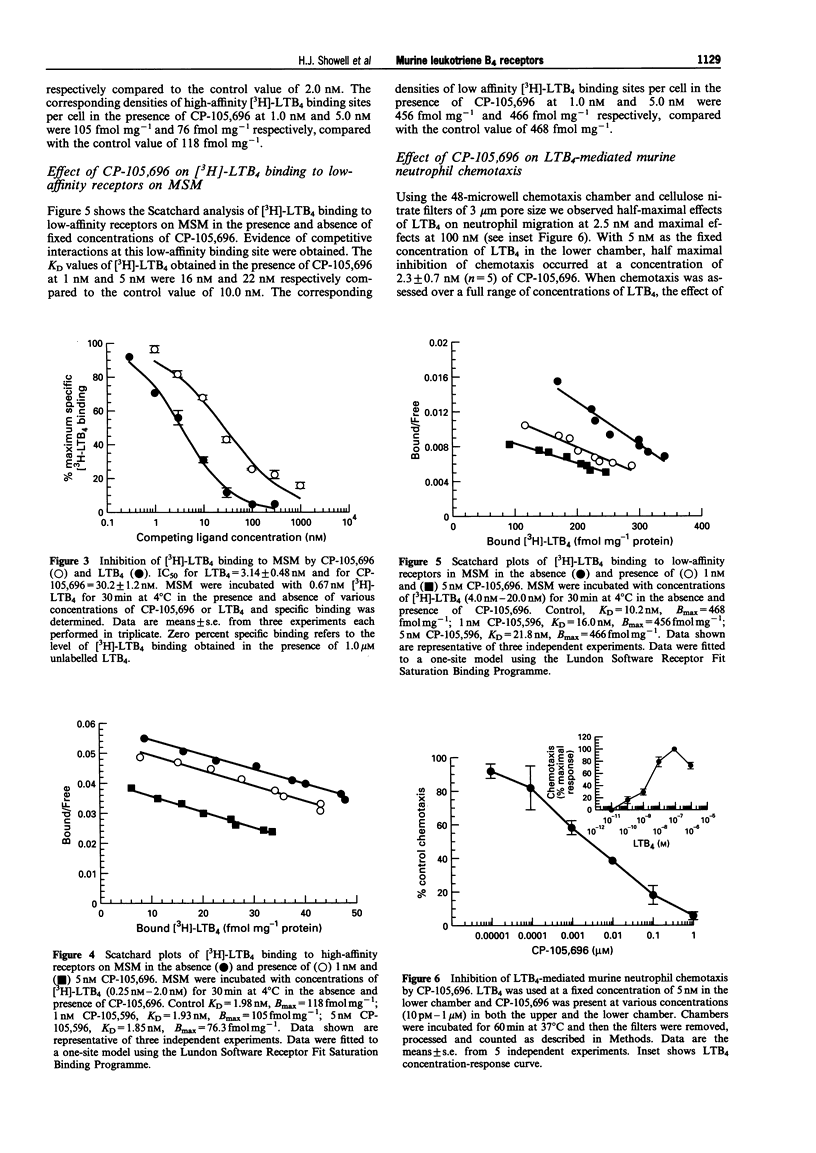
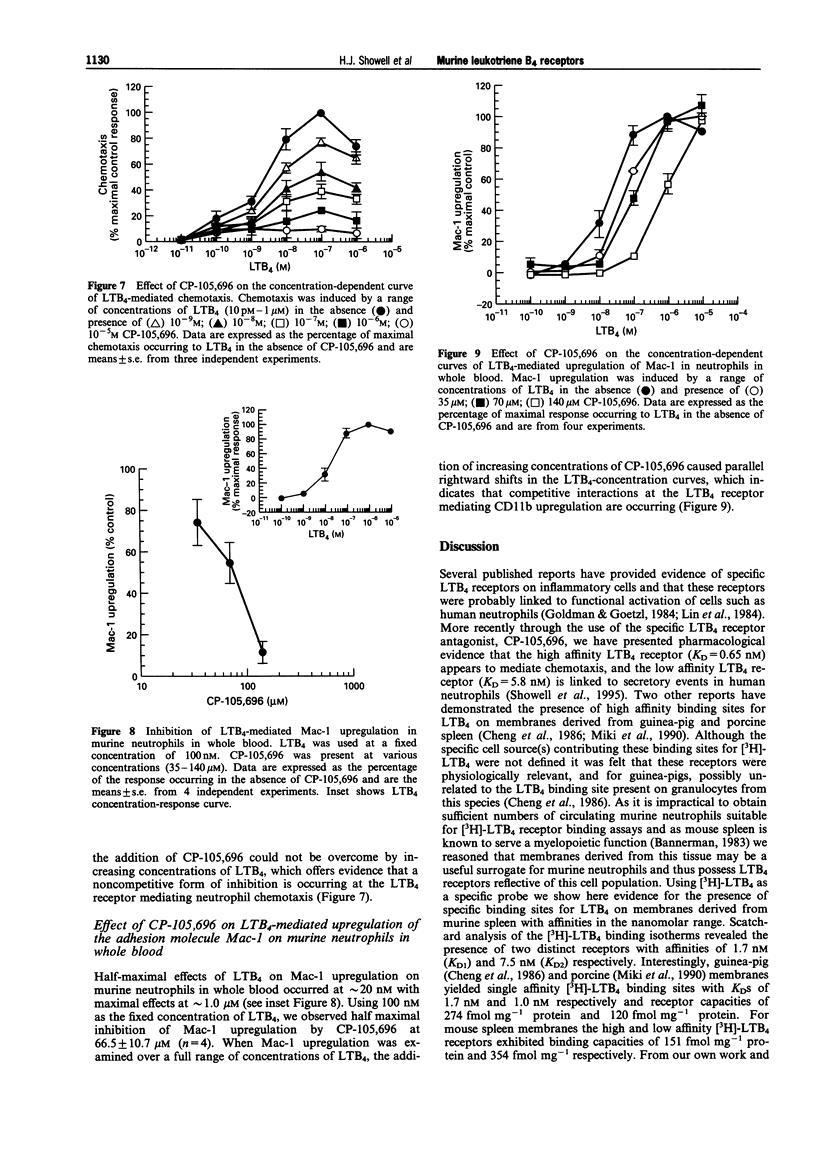
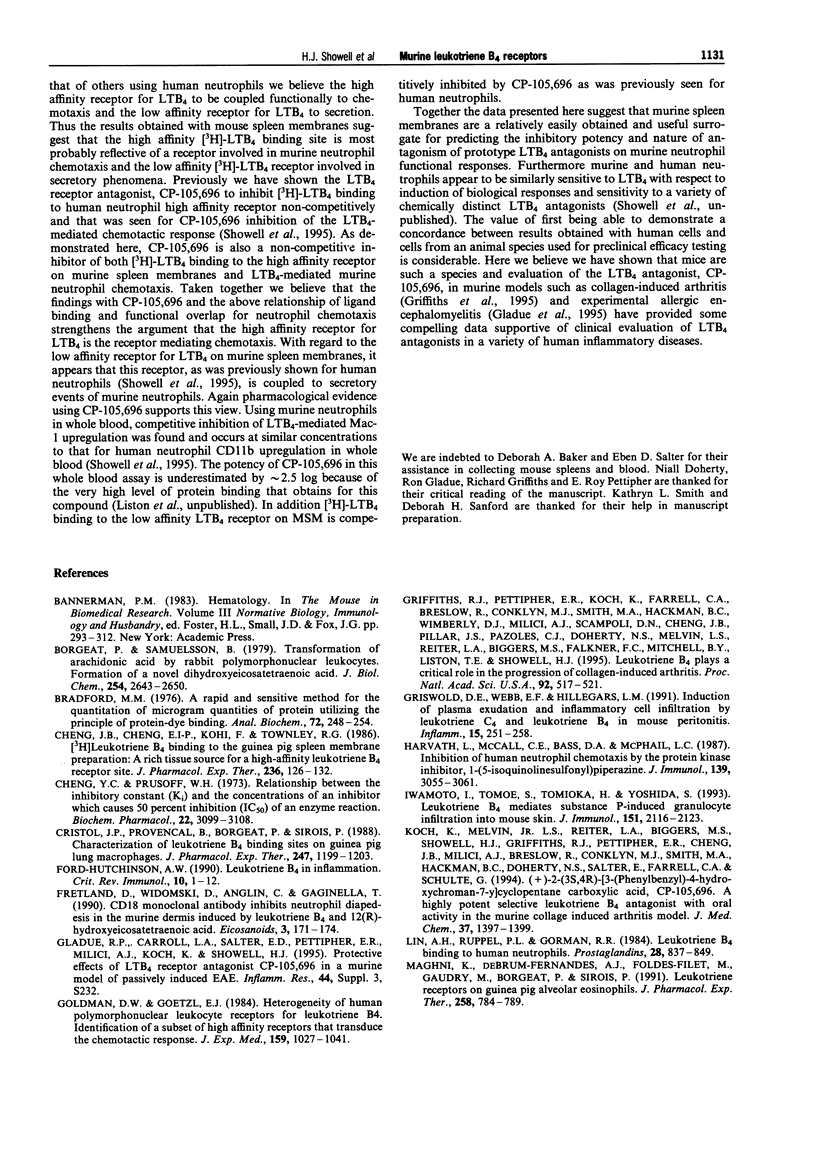
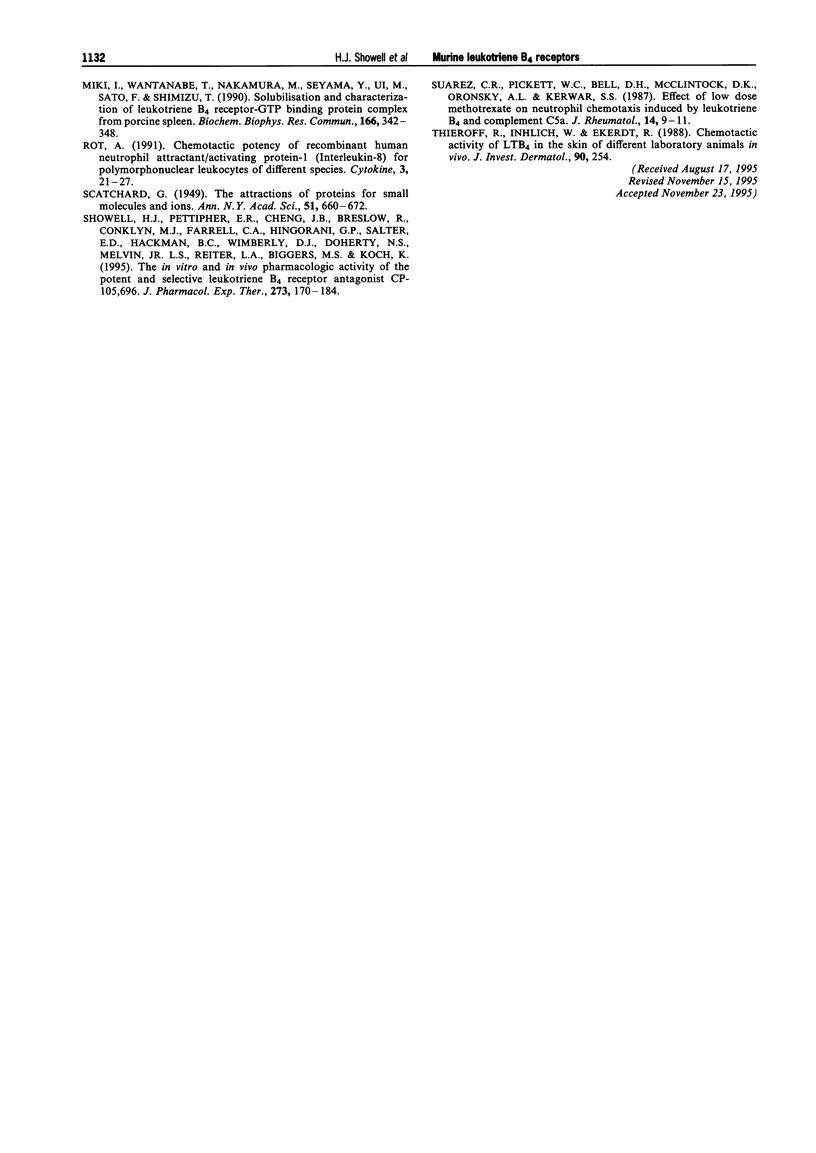
Selected References
These references are in PubMed. This may not be the complete list of references from this article.
- Borgeat P., Samuelsson B. Transformation of arachidonic acid by rabbit polymorphonuclear leukocytes. Formation of a novel dihydroxyeicosatetraenoic acid. J Biol Chem. 1979 Apr 25;254(8):2643–2646. [PubMed] [Google Scholar]
- Bradford M. M. A rapid and sensitive method for the quantitation of microgram quantities of protein utilizing the principle of protein-dye binding. Anal Biochem. 1976 May 7;72:248–254. doi: 10.1006/abio.1976.9999. [DOI] [PubMed] [Google Scholar]
- Cheng J. B., Cheng E. I., Kohi F., Townley R. G. [3H]leukotriene B4 binding to the guinea-pig spleen membrane preparation: a rich tissue source for a high-affinity leukotriene B4 receptor site. J Pharmacol Exp Ther. 1986 Jan;236(1):126–132. [PubMed] [Google Scholar]
- Cheng Y., Prusoff W. H. Relationship between the inhibition constant (K1) and the concentration of inhibitor which causes 50 per cent inhibition (I50) of an enzymatic reaction. Biochem Pharmacol. 1973 Dec 1;22(23):3099–3108. doi: 10.1016/0006-2952(73)90196-2. [DOI] [PubMed] [Google Scholar]
- Cristol J. P., Provençal B., Borgeat P., Sirois P. Characterization of leukotriene B4 binding sites on guinea pig lung macrophages. J Pharmacol Exp Ther. 1988 Dec;247(3):1199–1203. [PubMed] [Google Scholar]
- Ford-Hutchinson A. W. Leukotriene B4 in inflammation. Crit Rev Immunol. 1990;10(1):1–12. [PubMed] [Google Scholar]
- Fretland D., Widomski D., Anglin C., Gaginella T. CD 18 monoclonal antibody inhibits neutrophil diapedesis in the murine dermis induced by leukotriene B4 and 12(R)-hydroxyeicosatetraenoic acid. Eicosanoids. 1990;3(3):171–174. [PubMed] [Google Scholar]
- Goldman D. W., Goetzl E. J. Heterogeneity of human polymorphonuclear leukocyte receptors for leukotriene B4. Identification of a subset of high affinity receptors that transduce the chemotactic response. J Exp Med. 1984 Apr 1;159(4):1027–1041. doi: 10.1084/jem.159.4.1027. [DOI] [PMC free article] [PubMed] [Google Scholar]
- Griffiths R. J., Pettipher E. R., Koch K., Farrell C. A., Breslow R., Conklyn M. J., Smith M. A., Hackman B. C., Wimberly D. J., Milici A. J. Leukotriene B4 plays a critical role in the progression of collagen-induced arthritis. Proc Natl Acad Sci U S A. 1995 Jan 17;92(2):517–521. doi: 10.1073/pnas.92.2.517. [DOI] [PMC free article] [PubMed] [Google Scholar]
- Griswold D. E., Webb E. F., Hillegass L. M. Induction of plasma exudation and inflammatory cell infiltration by leukotriene C4 and leukotriene B4 in mouse peritonitis. Inflammation. 1991 Aug;15(4):251–258. doi: 10.1007/BF00917310. [DOI] [PubMed] [Google Scholar]
- Harvath L., McCall C. E., Bass D. A., McPhail L. C. Inhibition of human neutrophil chemotaxis by the protein kinase inhibitor, 1-(5-isoquinolinesulfonyl) piperazine. J Immunol. 1987 Nov 1;139(9):3055–3061. [PubMed] [Google Scholar]
- Iwamoto I., Tomoe S., Tomioka H., Yoshida S. Leukotriene B4 mediates substance P-induced granulocyte infiltration into mouse skin. Comparison with antigen-induced granulocyte infiltration. J Immunol. 1993 Aug 15;151(4):2116–2123. [PubMed] [Google Scholar]
- Lin A. H., Ruppel P. L., Gorman R. R. Leukotriene B4 binding to human neutrophils. Prostaglandins. 1984 Dec;28(6):837–849. doi: 10.1016/0090-6980(84)90038-8. [DOI] [PubMed] [Google Scholar]
- Maghni K., de Brum-Fernandes A. J., Földes-Filep E., Gaudry M., Borgeat P., Sirois P. Leukotriene B4 receptors on guinea pig alveolar eosinophils. J Pharmacol Exp Ther. 1991 Sep;258(3):784–789. [PubMed] [Google Scholar]
- Miki I., Watanabe T., Nakamura M., Seyama Y., Ui M., Sato F., Shimizu T. Solubilization and characterization of leukotriene B4 receptor-GTP binding protein complex from porcine spleen. Biochem Biophys Res Commun. 1990 Jan 15;166(1):342–348. doi: 10.1016/0006-291x(90)91951-n. [DOI] [PubMed] [Google Scholar]
- Rot A. Chemotactic potency of recombinant human neutrophil attractant/activation protein-1 (interleukin-8) for polymorphonuclear leukocytes of different species. Cytokine. 1991 Jan;3(1):21–27. doi: 10.1016/1043-4666(91)90006-y. [DOI] [PubMed] [Google Scholar]
- Showell H. J., Pettipher E. R., Cheng J. B., Breslow R., Conklyn M. J., Farrell C. A., Hingorani G. P., Salter E. D., Hackman B. C., Wimberly D. J. The in vitro and in vivo pharmacologic activity of the potent and selective leukotriene B4 receptor antagonist CP-105696. J Pharmacol Exp Ther. 1995 Apr;273(1):176–184. [PubMed] [Google Scholar]
- Suarez C. R., Pickett W. C., Bell D. H., McClintock D. K., Oronsky A. L., Kerwar S. S. Effect of low dose methotrexate on neutrophil chemotaxis induced by leukotriene B4 and complement C5a. J Rheumatol. 1987 Feb;14(1):9–11. [PubMed] [Google Scholar]


